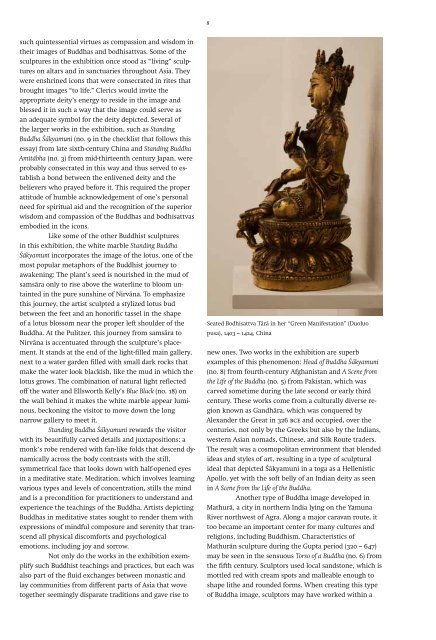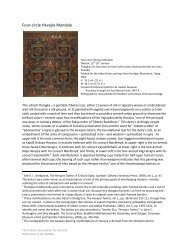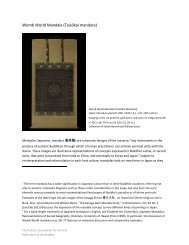Reflections of the Buddha - The Pulitzer Foundation for the Arts
Reflections of the Buddha - The Pulitzer Foundation for the Arts
Reflections of the Buddha - The Pulitzer Foundation for the Arts
Create successful ePaper yourself
Turn your PDF publications into a flip-book with our unique Google optimized e-Paper software.
such quintessential virtues as compassion and wisdom in<br />
<strong>the</strong>ir images <strong>of</strong> <strong>Buddha</strong>s and bodhisattvas. Some <strong>of</strong> <strong>the</strong><br />
sculptures in <strong>the</strong> exhibition once stood as “living” sculptures<br />
on altars and in sanctuaries throughout Asia. <strong>The</strong>y<br />
were enshrined icons that were consecrated in rites that<br />
brought images “to life.” Clerics would invite <strong>the</strong><br />
appropriate deity’s energy to reside in <strong>the</strong> image and<br />
blessed it in such a way that <strong>the</strong> image could serve as<br />
an adequate symbol <strong>for</strong> <strong>the</strong> deity depicted. Several <strong>of</strong><br />
<strong>the</strong> larger works in <strong>the</strong> exhibition, such as Standing<br />
<strong>Buddha</strong> Śākyamuni (no. 9 in <strong>the</strong> checklist that follows this<br />
essay) from late sixth-century China and Standing <strong>Buddha</strong><br />
Amitābha (no. 3) from mid-thirteenth century Japan, were<br />
probably consecrated in this way and thus served to establish<br />
a bond between <strong>the</strong> enlivened deity and <strong>the</strong><br />
believers who prayed be<strong>for</strong>e it. This required <strong>the</strong> proper<br />
attitude <strong>of</strong> humble acknowledgement <strong>of</strong> one’s personal<br />
need <strong>for</strong> spiritual aid and <strong>the</strong> recognition <strong>of</strong> <strong>the</strong> superior<br />
wisdom and compassion <strong>of</strong> <strong>the</strong> <strong>Buddha</strong>s and bodhisattvas<br />
embodied in <strong>the</strong> icons.<br />
Like some <strong>of</strong> <strong>the</strong> o<strong>the</strong>r Buddhist sculptures<br />
in this exhibition, <strong>the</strong> white marble Standing <strong>Buddha</strong><br />
Śākyamuni incorporates <strong>the</strong> image <strong>of</strong> <strong>the</strong> lotus, one <strong>of</strong> <strong>the</strong><br />
most popular metaphors <strong>of</strong> <strong>the</strong> Buddhist journey to<br />
awakening: <strong>The</strong> plant’s seed is nourished in <strong>the</strong> mud <strong>of</strong><br />
samsāra only to rise above <strong>the</strong> waterline to bloom untainted<br />
in <strong>the</strong> pure sunshine <strong>of</strong> Nirvāna. To emphasize<br />
this journey, <strong>the</strong> artist sculpted a stylized lotus bud<br />
between <strong>the</strong> feet and an honorific tassel in <strong>the</strong> shape<br />
<strong>of</strong> a lotus blossom near <strong>the</strong> proper left shoulder <strong>of</strong> <strong>the</strong><br />
<strong>Buddha</strong>. At <strong>the</strong> <strong>Pulitzer</strong>, this journey from samsāra to<br />
Nirvāna is accentuated through <strong>the</strong> sculpture’s placement.<br />
It stands at <strong>the</strong> end <strong>of</strong> <strong>the</strong> light-filled main gallery,<br />
next to a water garden filled with small dark rocks that<br />
make <strong>the</strong> water look blackish, like <strong>the</strong> mud in which <strong>the</strong><br />
lotus grows. <strong>The</strong> combination <strong>of</strong> natural light reflected<br />
<strong>of</strong>f <strong>the</strong> water and Ellsworth Kelly’s Blue Black (no. 18) on<br />
<strong>the</strong> wall behind it makes <strong>the</strong> white marble appear luminous,<br />
beckoning <strong>the</strong> visitor to move down <strong>the</strong> long<br />
narrow gallery to meet it.<br />
Standing <strong>Buddha</strong> Śākyamuni rewards <strong>the</strong> visitor<br />
with its beautifully carved details and juxtapositions: a<br />
monk’s robe rendered with fan-like folds that descend dynamically<br />
across <strong>the</strong> body contrasts with <strong>the</strong> still,<br />
symmetrical face that looks down with half-opened eyes<br />
in a meditative state. Meditation, which involves learning<br />
various types and levels <strong>of</strong> concentration, stills <strong>the</strong> mind<br />
and is a precondition <strong>for</strong> practitioners to understand and<br />
experience <strong>the</strong> teachings <strong>of</strong> <strong>the</strong> <strong>Buddha</strong>. Artists depicting<br />
<strong>Buddha</strong>s in meditative states sought to render <strong>the</strong>m with<br />
expressions <strong>of</strong> mindful composure and serenity that transcend<br />
all physical discom<strong>for</strong>ts and psychological<br />
emotions, including joy and sorrow.<br />
Not only do <strong>the</strong> works in <strong>the</strong> exhibition exemplify<br />
such Buddhist teachings and practices, but each was<br />
also part <strong>of</strong> <strong>the</strong> fluid exchanges between monastic and<br />
lay communities from different parts <strong>of</strong> Asia that wove<br />
toge<strong>the</strong>r seemingly disparate traditions and gave rise to<br />
8<br />
Seated Bodhisattva Tārā in her “Green Manifestation” (Duoluo<br />
pusa), 1403 – 1424, China<br />
new ones. Two works in <strong>the</strong> exhibition are superb<br />
examples <strong>of</strong> this phenomenon: Head <strong>of</strong> <strong>Buddha</strong> Śākyamuni<br />
(no. 8) from fourth-century Afghanistan and A Scene from<br />
<strong>the</strong> Life <strong>of</strong> <strong>the</strong> <strong>Buddha</strong> (no. 5) from Pakistan, which was<br />
carved sometime during <strong>the</strong> late second or early third<br />
century. <strong>The</strong>se works come from a culturally diverse region<br />
known as Gandhāra, which was conquered by<br />
Alexander <strong>the</strong> Great in 326 bce and occupied, over <strong>the</strong><br />
centuries, not only by <strong>the</strong> Greeks but also by <strong>the</strong> Indians,<br />
western Asian nomads, Chinese, and Silk Route traders.<br />
<strong>The</strong> result was a cosmopolitan environment that blended<br />
ideas and styles <strong>of</strong> art, resulting in a type <strong>of</strong> sculptural<br />
ideal that depicted Śākyamuni in a toga as a Hellenistic<br />
Apollo, yet with <strong>the</strong> s<strong>of</strong>t belly <strong>of</strong> an Indian deity as seen<br />
in A Scene from <strong>the</strong> Life <strong>of</strong> <strong>the</strong> <strong>Buddha</strong>.<br />
Ano<strong>the</strong>r type <strong>of</strong> <strong>Buddha</strong> image developed in<br />
Mathurā, a city in nor<strong>the</strong>rn India lying on <strong>the</strong> Yamuna<br />
River northwest <strong>of</strong> Agra. Along a major caravan route, it<br />
too became an important center <strong>for</strong> many cultures and<br />
religions, including Buddhism. Characteristics <strong>of</strong><br />
Mathurān sculpture during <strong>the</strong> Gupta period (320 – 647)<br />
may be seen in <strong>the</strong> sensuous Torso <strong>of</strong> a <strong>Buddha</strong> (no. 6) from<br />
<strong>the</strong> fifth century. Sculptors used local sandstone, which is<br />
mottled red with cream spots and malleable enough to<br />
shape li<strong>the</strong> and rounded <strong>for</strong>ms. When creating this type<br />
<strong>of</strong> <strong>Buddha</strong> image, sculptors may have worked within a




